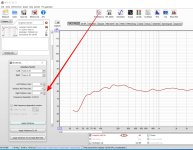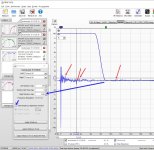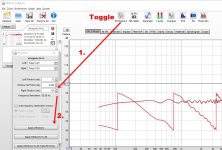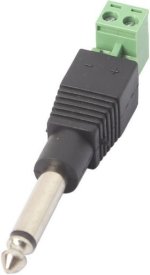Works also for "All SPL" ie. for several measurements. This setting is not saved.I couldn’t find gating in REW. Not even in a help search. Gotta be there somewhere.



The baffle is 1/2”, and I agree that may be part of what’s muddying the sound. Bracing might help some. I wonder if that can be measured?
Perhaps distortion can tell it? First take semi-nearfield sweep with high spl. Then look at distortion and if there is a peak (typically H3), play that F with sinewave generator and listen to the thing. Then put your hand on the baffle to feel the vibes and listen if the sound changes.
Last edited:
Peut être ? You can use a frequency generator and sweep and touch the wood to detect the vibration. A sensor of vibration will be better and it exists. Perhaps if you "stick" the microphone on wood it can work as a vibration sensor.The baffle is 1/2”, and I agree that may be part of what’s muddying the sound. Bracing might help some. I wonder if that can be measured?
Linkwitz on his Orion noticed this problem of vibration. In his next design LX521 he isolated the woofers of the rest of speaker.
But I see the gated curve, you have 2 dips 250Hz and 750Hz, between you have stored energy (mass air resonance) which have a negative impact on the midrange, it's my observation, doing a CSD. I think you can minimize this effect with a crossover work and the help of the tweeter, low slope could help. You have the same problem on the Manzanita and the vifa mid helps a lot
Doh! I have probably used the Window adjustment, but couldn't remember where it was. Hiding in plain sight.Works also for "All SPL" ie. for several measurements. This setting is not saved.
Good ideas for looking at the baffle, I am NOT happy with that 1/2" MDF, but it's what I could get. Perhaps I will generate a slow sweep from 50 to 700Hz and keep a hand on the baffle while it plays. Feeling for a peak resonance should not be difficult. Wish me luck!
Palpating for a resonance is not particularly easy; unless you’ve been trained to do so.
Another option of checking for panel resonances without driving your speakers from the amplifier, is to connect the terminals of the speaker to the input of the audio interface. I keep one of these around -
The 1/4” Jack goes into your audio interface, and the speaker terminals go to the screw terminals. So now your baffle mounted speaker work as a microphone; by the way of reciprocity-
it’s a microphone for your baffle- you tap/knock on your baffle at various points, and whilst watching the FFT using the RTA function in REW.
Another option of checking for panel resonances without driving your speakers from the amplifier, is to connect the terminals of the speaker to the input of the audio interface. I keep one of these around -

The 1/4” Jack goes into your audio interface, and the speaker terminals go to the screw terminals. So now your baffle mounted speaker work as a microphone; by the way of reciprocity-
it’s a microphone for your baffle- you tap/knock on your baffle at various points, and whilst watching the FFT using the RTA function in REW.
Last edited:
It is hidden in IR Windows settings and can be applied to measurements later, also gating can be removed if needed, just increase Right Window to big value, default in REW is 500 ms.I couldn’t find gating in REW. Not even in a help search. Gotta be there somewhere.
Right Window value define gating in ms. On Impulse response you can see defined window and also decide how many reflections can be involved in window.
If you drag green R letter on Impulse response, REW opens additional FR windows below IR what helps to define needed gate window.
Last edited:
Interesting, as I had ended up by removing wings from my ex-OB to get to sound right 
I still suspwct that the thin baffle is to blame. Two things come to my mind:
Easy-kill the baffle resonance by gluing bitumen pads onto it, and/or
Harder-Try to fabricate sort-of-frame that would hold the speaker by the magnet, and it would in fact be decoupled from the baffle, with only a thicker rubber ring around a rim of the driver, "kissing"the baffle, but in fact being mechanicaly detached, only loosely coupled...
I still suspwct that the thin baffle is to blame. Two things come to my mind:
Easy-kill the baffle resonance by gluing bitumen pads onto it, and/or
Harder-Try to fabricate sort-of-frame that would hold the speaker by the magnet, and it would in fact be decoupled from the baffle, with only a thicker rubber ring around a rim of the driver, "kissing"the baffle, but in fact being mechanicaly detached, only loosely coupled...
That's a good idea that would certainly help, but it's not going to happen. These are just test baffles that I had wanted to be twice as thick. There is little time left to work on them because, next week the drivers will go back into their cardboard boxes where, much like the black bears that roam these hills, the will be in hibernation until the spring of 2024. I will be returning to the tropics.
Sunday I will add some bracing and some wings to hear if that helps. There should be time on Sunday for some crossover work.
Sunday I will add some bracing and some wings to hear if that helps. There should be time on Sunday for some crossover work.
Perhaps I will generate a slow sweep from 50 to 700Hz and keep a hand on the baffle while it plays. Feeling for a peak resonance should not be difficult. Wish me luck!
No need to generate a file. Use REW Generator "online" and slide the frequency slowly while playing. You will hear the resonance and perhaps locate it by listening very close, then let it play that F and adjust spl. Then by touching various parts of the speaker you can hear if the resonance attenuates. Keeping the hand on the baffle while sweeping propably kills the resonance, so don't touch it until you hear the buzz.
I was surprised how sensitive this method is, when I couldn't even hear the resonance in normal measurement sweep! It can be loose mounting of the driver, a wire touching the baffle, uneven stands etc. beside the baffle itself.
Two (diy) speakers will be different!

No need to generate a file. Use REW Generator "online" and slide the frequency slowly while playing. You will hear the resonance and perhaps locate it by listening very close, then let it play that F and adjust spl. Then by touching various parts of the speaker you can hear if the resonance attenuates. Keeping the hand on the baffle while sweeping propably kills the resonance, so don't touch it until you hear the buzz.
I was surprised how sensitive this method is, when I couldn't even hear the resonance in normal measurement sweep! It can be loose mounting of the driver, a wire touching the baffle, uneven stands etc. beside the baffle itself.
Two (diy) speakers will be different!
It is not very clear from measurements where is first dipole peak as gated measurement lowest frequency level is not very definite, level of one octave higher is reliable. But clear is that first dipole minimum is at 750-800 Hz.There is a big peak at 420 right where the prediction says it will be.
I need wings.
Wings will move peak and minimum to lower frequency, not remove them or decrease peak as it is dipole peak and minimum.
Baffle damping also nearly will not help.
Only way I see, is to make smaller baffle what turns first dipole peak and first minimum up and make possible to use LP filter what fits with tweeter HP filter. But there is draw back, smaller baffle means less bass.
Test them with just one wing on the outside edge before you put the other side on, the asymmetry really softens the dipole peaks and dips. Unless you're going for complete symmetry with this design, which I often do also. Does the image appear to be behind the speakers on some recordings as you have them set up? I enjoy this effect for some reason.
It is nearly impossible to deal with dipole minimums in other way than to push them out from needed frequency range with baffle size optimization, only first dipole peak is useful, second and other higher peaks are only problems.
It is more easy to increase bass with DSP than manage dipole peaks and minimums, only big Xmax spare is needed. There are also polar response changes at dipole peaks and minimums what cannot be at all compensated with DSP.
It is more easy to increase bass with DSP than manage dipole peaks and minimums, only big Xmax spare is needed. There are also polar response changes at dipole peaks and minimums what cannot be at all compensated with DSP.
Yes, I have experimented with this before, thanks for mentioning it. I might even put a 12" wide wing on one side and none on the other to the help the asymmetry. Originally 8" wings were used on both sides.est them with just one wing on the outside edge before you put the other side on, the asymmetry really softens the dipole peaks and dips.
Raw response of 2x10" mtm with 4" fullrange after adding a 10.5" wing to one side angled out 12degrees off of right angle. 1.5" wing on the inside edge. Asymmetry is effective. These speakers hang from the ceiling in the spin studio of a local gym. Took quite a few baffles to get it this smooth with no filter. I prefer symmetry for home listening, and as you say one must be strategic with driver size and crossover points in that case.

Your comment popped in as I was typing. Sounds like you have a fun weekend in the works!Yes, I have experimented with this before, thanks for mentioning it. I might even put a 12" wide wing on one side and none on the other to the help the asymmetry. Originally 8" wings were used on both sides.
Here are a couple of quick measurements made today. I added a cross brace below the woofer, then one wing, then another wing. Wings are ~22cm deep.
The brace didn't do much, but the wings did. Notice how they killed the dip 806 Hz. These measurements are all at 1 meter from the baffle, speaker in the middle of the room. Wing measurements are gated @6ms

No cross brace, then brace added.

The brace didn't do much, but the wings did. Notice how they killed the dip 806 Hz. These measurements are all at 1 meter from the baffle, speaker in the middle of the room. Wing measurements are gated @6ms
No cross brace, then brace added.
- Home
- Loudspeakers
- Multi-Way
- 18" Coax on Open Baffle BM18CX-38